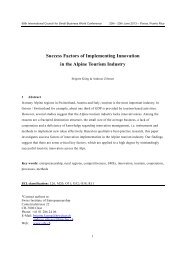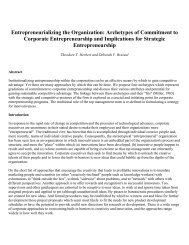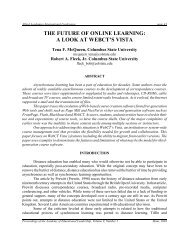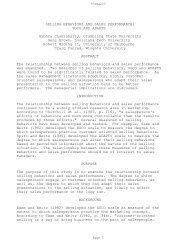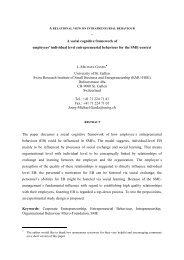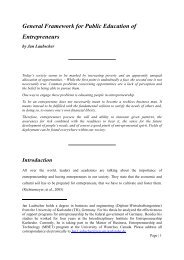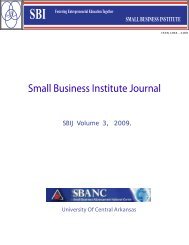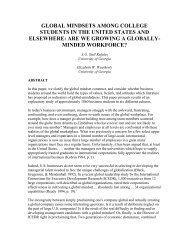O - Small Business Advancement National Center
O - Small Business Advancement National Center
O - Small Business Advancement National Center
You also want an ePaper? Increase the reach of your titles
YUMPU automatically turns print PDFs into web optimized ePapers that Google loves.
Kazakhstan: Emerging Issues of Female<br />
Entrepreneurship (1)<br />
Anatoly V. Zhuplev Loyola Marymount University 7900 Loyola Boulevard Los Angeles,<br />
CA 90045-8385 Tel: (310) 376-4712 home (310) 338-7414 office<br />
Jeanne Almaraz Loyola Marymount University 7900 Loyola Boulevard Los Angeles,<br />
CA 90045-8385 Tel: (310) 338-2989 office Fax: (949) 759-4964<br />
Asylbeck B. Kozhakhmetov Almaty Management School P.O. Box 480057 58 Zhandosov<br />
St., Almaty Republic of Kazakhstan Tel: 73272-457003 office<br />
Janat Berdalina KPMG Janat 105 Abulai Khan Ave Almaty 480091 Republic of<br />
Kazakhstan Tel: 73272-622694 office<br />
Abstract<br />
This article explores the emergence of female entrepreneurship in Kazakhstan under the<br />
market transition to a more open competitive environment. In this traditional culture<br />
women have been publicly "invisible" and inactive in entrepreneurship. Economic<br />
survival and an increasing international influence are changing such traditions. A survey<br />
in Kazakhstan identified current entrepreneurial trends, motivations, and gender-related<br />
issues. Entrepreneurial motivations among females are found to be more internally- and<br />
family-driven than among males. The survey found no substantial gender-related<br />
differences in perceived difficulties of entrepreneurship. As Kazakhstan moves into the<br />
mid-term of its socio-economic development, the emergence of female entrepreneurship<br />
is likely to continue, integrating elements of Kazakhstani cultural traditions, European<br />
social market concepts and American rationality.<br />
Introduction<br />
This research project traces the history of the Kazakh nation, the market transition<br />
currently underway and the valiant attempt of the government at privatization. The<br />
discussion then turns to the small business sector focusing specifically on the emergence<br />
of female entrepreneurs in Kazakhstan. As social and political change have spearheaded<br />
the transition to a market economy, women are increasingly undertaking entrepreneurial<br />
ventures. These choices are driven by financial necessity and by the influence of western<br />
culture on the traditional culture of Kazakh households.<br />
At a women's convention held in Almaty, Kazakhstan's capital, a questionnaire was<br />
distributed to gather demographic information on women entrepreneurs and to identify<br />
the motivations and concerns of women entrepreneurs in the transition economy of<br />
Kazakhstan. Questions were also posed to query differences in issues among male versus<br />
female entrepreneurs. This paper will present the results of this questionnaire.
The History of Kazakhstan<br />
There is no exact agreement on the origination of the Kazakh (2) people, largely because<br />
of the lack of contemporary sources (Olcott, 1987, p. 3). Over the centuries, various parts<br />
of Kazakhstan were incorporated into different empires. The country was integrated into<br />
Russia in the 18th century and occupied by the Red Army after the revolution of 1917<br />
and Civil War. In 1920, the Soviet government established the Kyrgyz Autonomous<br />
Republic, and in 1925 changed its name to Kazakh A.S.S.R. From 1927 the Soviet<br />
government pursued a vigorous policy of transforming the Kazak nomads into a settled<br />
population and of colonizing the region with Russians and Ukrainians.<br />
Kazakhstan formally became a constituent (union) republic of the Soviet Union in 1936.<br />
Under Nikita Khrushchev, the role of Kazakhstan within the Soviet Union increased<br />
dramatically. The Virgin and Idle Lands program launched in 1953 opened up the vast<br />
grasslands of northern Kazakhstan to wheat farming by Slavic settlers. As the Soviet<br />
Union collapsed, Kazakhstan declared sovereignty on October 25, 1990 followed by<br />
gaining its full independence on December 16, 1991 (Central Asia: "The Countries of<br />
Central Asia" Britannica Online [Accessed 18 August 1998]).<br />
Market Transition<br />
Despite its huge territory and some important natural resources, Kazakhstan is relatively<br />
unknown to the world. It is the largest state in Central Asia, the ninth largest in the world,<br />
and second in size after Russia in the Newly Independent States (NIS). Larger than<br />
Western Europe and approximately four times the size of Texas, Kazakhstan is among<br />
the most sparsely populated countries in the world, with just 16.1 persons per square<br />
mile.<br />
With a total population of 16.9 million (46% Kazakh, 35% Russian, 5% Ukrainian, 14%<br />
other nationalities), Kazakhstan's work force is well educated. Nearly the entire<br />
population is literate, with 64% of the population 15 years and older have a secondary<br />
education, and 10% having attained higher education (Worldfact Book, 1997).<br />
President Nursultan Nazarbayev, an ethnic Kazakh, is not following Moscow's bid for<br />
democracy at any price. He has instead declared his admiration for the political models of<br />
Singapore and other Asian countries (Fletcher, 1994). Nazarbayev's fiscal programs and<br />
commitment to Westernization of the Kazakh economy make him a favorite of foreign<br />
investors. But his domestic agenda involves a tricky juggling act between a program of<br />
"Kazakhstanization", which seeks to reaffirm traditional culture and bolster the status of<br />
indigenous Kazakhs, and multiculturalism (Reyen, 1996).<br />
The government plays a leading role in directing national economic development. Since<br />
1995, a number of presidential decrees were signed into law, addressing among other<br />
things the following: banking, bankruptcy, customs, taxes, stock exchanges, insurance,
oil, land, aviation, accounting, and electric power. As a part of its reforms, the<br />
government encourages small and medium-size businesses in rural areas, in order to<br />
employ the available workforce locally in labor-intensive activity and to discourage<br />
further urbanization. This is particularly understandable given that in 1989 the revenue<br />
share of the poorest two- fifths of the population was only 23% of all personal revenues;<br />
in 1994 this share dropped to 19%. The upper one-fifth had the same share - 34% - in<br />
both years, and the middle class gained an increasing share. A study of 6,000 households<br />
in August 1995 identified 84% of the rural, and 44% of the urban, households living<br />
below the poverty line.<br />
The Move to Privatization<br />
Privatization is the key part of the economic transformation in Kazakhstan. Its program<br />
began in 1991 and currently includes four elements: (a) privatization of small businesses,<br />
(b) mass privatization, (c) privatization in agriculture, and (d) individual project<br />
privatization.<br />
Privatization of small businesses involves the privatization of wholesale and retail trade<br />
companies, food service companies, cargo and passenger transportation and services<br />
formerly owned and operated by the state. <strong>Business</strong>es that employ fewer than 200 people<br />
are sold at auctions for cash. Their sales provide government earnings and guarantees that<br />
the industry is not going to be monopolized. Besides, the relatively low price of these<br />
businesses makes them affordable which allows expansion of the number of small private<br />
owners.<br />
Mass privatization involves creation of conditions for the public to exercise its right to<br />
sell and buy securities. This direction includes all the companies that are not part of the<br />
agroindustrial complex and are not subject to small business or individual project<br />
privatization.<br />
Privatization in agriculture involves companies that process agricultural products and<br />
provide services. Privatization of the agricultural sector is being implemented alongside<br />
mandatory allocation of property and land shares to new owners. The public can buy<br />
former government-owned agricultural businesses; a partial transfer also is allowed.<br />
Individual project privatization involves large companies that have a monopoly position<br />
(excluding companies that export their product) and play a strategic role in the overall<br />
economy. Individual projects are sold to the highest bidder under certain conditions, or at<br />
auctions, through tenders, management contracts, and through public offerings<br />
(Rysbekov, 1995).<br />
Problems in the Privatization Process<br />
Privatization in Kazakhstan has been impeded by a number of factors. First, inventory of<br />
the small businesses subject to privatization was not completed, and, as a result, a<br />
significant number of companies to be sold at auctions were withdrawn. Second, little
interest was shown on the part of the population in the privatization of small businesses<br />
because of the reduction in buying power and auctioning of less attractive businesses.<br />
Third, attempts were made on the part of management and workers of some small<br />
businesses to discourage selling of their companies. Fourth was the closing of companies<br />
for a long time due to the lack of funds for repairs and inability to start production, trade,<br />
or any other activity. Finally, privatization was impeded by the resistance on the part of<br />
local authorities who lost both businesses and their share in the profits of these<br />
businesses.<br />
Today the level of denationalization is fairly high. The Government has been successful<br />
in privatizing many small- and medium-size firms, and is working to privatize large-scale<br />
industrial complexes, particularly in the oil and gas sector. In industry, state-owned<br />
enterprises account for 40% of overall production volume; in agriculture, the state's share<br />
is only 3%. However, the main goal of creating an efficient private sector and a<br />
competitive environment has not yet been implemented (Rysbekov, 1995). Living<br />
standards for many citizens continue to decline. According to several surveys, nearly<br />
35% of citizens live below the government-defined poverty line of $50 per month<br />
(Human Rights Report, 1998).<br />
<strong>Small</strong> <strong>Business</strong> Sector<br />
In the mid-1990s, there were an estimated 2,000-3,000 industrial enterprises in<br />
Kazakhstan, and several dozen huge enterprises accounted for a disproportionate share of<br />
total production. By 1995, two- thirds of this production was concentrated in heavy<br />
industry, including 17% in machine building, 16% in energy, and 9% in chemicals. Light<br />
industry and food processing each account for 15% of production. The small business<br />
sector is comprised of more than 3500 cooperatives, 15,000 small enterprises, 11,000<br />
private enterprises, and 15,600 farms. Among existing small enterprises, most operate in<br />
either wholesale and retail trade, or in catering businesses. Historically, small business<br />
and entrepreneurship were never viable avenues in Kazakhstan's political and socioeconomic<br />
development. At the present time, the small and medium-sized business sectors<br />
in Kazakhstan are weak, having little in common with a genuine full-fledged<br />
entrepreneurial venture, involving substantial investment. Currently, the main<br />
entrepreneurial activities focus on broker operations and operations with currency and<br />
trade (Arynov and Zhulamanov, 1994, p.4,5).<br />
Status of Women in Kazakh Culture<br />
From a cultural perspective, both Kazakh traditional values and the effects of Soviet rule<br />
have defined the role of women in the economic development of Kazakhstan over the<br />
past seven decades. Traditionally, marriage and dedication to the family were central in<br />
the life of a Kazakh woman. Women were generally married by age thirteen or fourteen,<br />
men by fifteen or sixteen. Parents arranged marriages, sometimes as early as ten years<br />
before the event. The Kazakhs have a much higher birthrate than the Russians do: while<br />
the size of the average Kazakh family size is 5.5, Russian families average 3.3 members.<br />
A survey of Kazakh women in the mid 1970s indicated that most Kazakh women both
wanted and expected to have five or more children, whereas the Russians anticipated<br />
having only two or three (Olcott, 1987, p.250). The current capitalist transition has<br />
created conflict with this traditional demographic pattern making it difficult for Kazakh<br />
women to combine their family role with a full-time corporate job or running a business.<br />
In the late 1980s-early 1990s, women comprised a sizable share of the labor pool. By the<br />
mid-1990s, 2.3 million women were employed in the economy of Kazakhstan (47% of<br />
the total workforce). In some industries and professions (3), the share of female<br />
employment was quite high: 63% in wholesale and retail trade, catering and consumer<br />
goods distribution; 84% in medical care, sports and welfare; 74% in public education;<br />
68% in entertainment, culture and arts; 56% in science and scientific services; 73% in<br />
banking and insurance, and 48% in government. Women also comprised 53% of those<br />
enrolled at higher education institutions and 59% of the junior college enrollment in<br />
Kazakhstan (O Polozhenii Sem'i i Zhenschin, 1996). Although structurally this pattern of<br />
educational access and employment still remains, it is shifting under the market<br />
transition. One event driving this shift is the growing pressure of change resulting in<br />
downsizing, an occurrence that often results in women losing their positions to men.<br />
Trends Driving the Emergence of Female Entrepreneurship<br />
In spite of the fact that men were considered the "head of the family", responsible for its<br />
overall well-being, even during the time of Soviet leadership it was difficult to feed an<br />
entire family if only one spouse worked. Such financial constraints challenged Kazakh<br />
women's traditional homebound status and pushed them towards outside employment.<br />
The Soviet Constitution guaranteed women the equality of rights in all aspects of life, but<br />
did not change the woman's role in a family. Thus, women had to work full time and at<br />
the same time take care of the family. That is why employers and employees often<br />
tolerated the underperformance of women with families and children (Kolobaeva, 1995).<br />
In essence, the value and contribution of Kazakhstani women in the workplace was<br />
invisible.<br />
A recent international conference on women's issues identified the invisibility of Kazakh<br />
women as an archenemy of the women's movement. This is true not simply because<br />
women have long been invisible to men, but because in such societies women become<br />
invisible to themselves. The prevailing stereotypes about women were described as<br />
follows:<br />
"If a woman is successful in a career, then people think that everything is not good in her<br />
private life. A woman in politics is rare, in arts she is marginal, in science she is<br />
industrious but not creative. A woman in the East is a special phenomenon. She combines<br />
European independence and Asian domestication. She is part tiger, part snake"<br />
(Chittister, 1995. p.31).<br />
An Empirical Probe of Factors Driving the Movement<br />
Toward Female Entrepreneurship in Kazakhstan
Given the tremendous social and political upheaval occurring in Kazakhstan, there are<br />
many questions about how women, especially women entrepreneurs, are coping. Are they<br />
becoming more invisible? Are they able to implement entrepreneurial ventures? What are<br />
their motivations? What problems and difficulties are they encountering? To address such<br />
questions, a comparative survey of motivations and problems of female entrepreneurship<br />
was developed. The survey was written in Russian (since Russian is spoken by the<br />
majority of the population) and administered to 100 respondents in Kazakhstan in the Fall<br />
1997, during a women's convention held in Almaty, the country capital. Respondents<br />
were asked to give their perceptions on 82 variables, addressing the following issues: (A)<br />
The current situation and trends in female entrepreneurship in Kazakhstan; (B) Individual<br />
motivation towards entrepreneurship; and (C) problems and difficulties experienced in<br />
the entrepreneurial process. When answering questions about motivation, problems and<br />
difficulties of the entrepreneurial process, respondents were asked to differentiate<br />
between these issues as faced by women versus men. Questions were written using a 7-<br />
point Likert scale. Demographic data was also collected. Descriptive data was analyzed<br />
using the SPSS statistical package.<br />
Respondents' Profile<br />
In order to gain insights into the rarely articulated perceptions of women regarding<br />
entrepreneurship in Kazakhstan, more than 90% of respondents were female. The<br />
majority (70%) of respondents were in their 20s and 30s (please refer to Table 1). More<br />
than 80% of them have significant educational accomplishments, which include some<br />
college education, college, or a master's degree. Only 18% of respondents had greater<br />
than 5 years of entrepreneurial experience -- an expected characteristic in Kazakhstan's<br />
emerging market economy, where independent business ventures have only been legal<br />
since the early 1990s. Most respondents indicated their job/business affiliation was with<br />
small organizations. In fact, 13% of respondents were the only employees on the payroll.<br />
More than 50% of respondents indicated that their organizations employed fewer than 10<br />
people. Entrepreneurial ventures in Kazakhstan are a relatively new phenomenon, a fact<br />
reflected in the extremely low sales volumes reported: 18% of respondents earned less<br />
than $5,000 a year in annual sales, 42% earned between $5,000 and $100,000; 1% earned<br />
between $5 million and $10 million, and only 1% reported their sales as exceeding $10<br />
million a year.<br />
Age, full years<br />
Under 20<br />
21-30<br />
31-40<br />
41-50<br />
51-60<br />
Table 1<br />
Respondents' Profile<br />
Personal data Responses, %<br />
1<br />
28<br />
42<br />
18<br />
11
Gender<br />
Male<br />
Female<br />
Marital Status<br />
Married<br />
Single<br />
Single with children<br />
Other<br />
Educational Accomplishments<br />
High school<br />
Community college<br />
Some college<br />
College degree<br />
Master's degree<br />
Experience in Entrepreneurship, years<br />
Less that 1 year<br />
1-2<br />
3-5<br />
More than 5<br />
Missing cases<br />
Number of Employees in Respondent's<br />
Organization<br />
None, except for the respondent him/herself<br />
1 other employee<br />
2-5<br />
6-10<br />
11-50<br />
51-100<br />
More than 100<br />
Missing cases<br />
8<br />
92<br />
58<br />
26<br />
13<br />
3<br />
2<br />
2<br />
9<br />
80<br />
7<br />
22<br />
19<br />
26<br />
18<br />
15<br />
13<br />
27<br />
15<br />
11<br />
8<br />
1<br />
1<br />
24
Table 1 Cont.<br />
Annual Sales, $US, thousand<br />
less than 5 thousand<br />
5-20<br />
21-50<br />
51-100<br />
101-500<br />
501-5,000<br />
5,001-10,000<br />
More than 10,000<br />
Missing cases<br />
Increasing Acceptance of Female Entrepreneurship<br />
The majority of respondents felt that female entrepreneurship should be among the most<br />
important national priorities (Please refer to Table 2) deserving greater attention on the<br />
part of the mass media, social groups, other public institutions, as well as the government<br />
of Kazakhstan.<br />
18<br />
16<br />
11<br />
15<br />
6<br />
0<br />
1<br />
1<br />
31<br />
Table 2<br />
Current Situation and Trends in Female Entrepreneurship<br />
Female entrepreneurship should be<br />
considered among the most important<br />
priorities in Kazakhstan's socio-economic<br />
development<br />
Female entrepreneurship deserves greater<br />
attention on the part of mass media, social<br />
movements, and other public institutions of<br />
Kazakhstan<br />
Female entrepreneurship deserves greater<br />
attention on the part of the government of<br />
Kazakhstan<br />
The degree of participation of women in<br />
Kazakhstan in entrepreneurship should be<br />
greater<br />
Current degree of participation in<br />
entrepreneurship among women in<br />
Kazakhstan is greater compared to other NIS<br />
countries<br />
% of "Agree" and<br />
"Totally agree"<br />
Responses<br />
% of "Disagree""<br />
and "Totally<br />
disagree" Responses<br />
75.7 3<br />
65.7 3<br />
81.8 4<br />
69.1 2.2<br />
26.1 32.3
Table 2 Cont.<br />
Current degree of participation in entrepreneurship among women in<br />
Kazakhstan is greater compared to other Central Asian countries<br />
In Kazakhstan, women, compared to men, are less effective as entrepreneurs<br />
and managers<br />
In Kazakhstan, men, compared to women, are less effective as entrepreneurs<br />
and managers<br />
In Kazakhstan, the religious norms and traditions are the obstacle for<br />
entrepreneurship<br />
In Kazakhstan, the ethnic, public, and family norms and traditions are obstacles<br />
for entrepreneurship<br />
45.3 16.8<br />
30.6 39.8<br />
20.6 30.5<br />
19.4 53.8<br />
23.7 46.2<br />
Sixty-nine percent of respondents suggest that the degree of participation in<br />
entrepreneurship among women of Kazakhstan should be greater. Approximately equal<br />
amount of respondents expressed either their strong agreement (30.6%) or disagreement<br />
(39.8%) that women, compared to men, are less effective as entrepreneurs and managers.<br />
The opposite statement that men, compared to women, are less effective as entrepreneurs<br />
and managers was agreed with by 19.4% and disagreed with by 30.5% of respondents.<br />
Religious norms and traditions are considered obstacles to entrepreneurship by 19.8% of<br />
respondents, although 53.8% disagreed with this statement. Similar views were held<br />
regarding ethnic, public, and family norms and traditions as obstacles to entrepreneurship<br />
in Kazakhstan, with 23.3% agreeing and 46.2% disagreeing.<br />
Motivations toward Entrepreneurship<br />
We asked our respondents to what extent certain factors motivate men and women in<br />
Kazakhstan to engage in entrepreneurial activities. Among twenty four motivations, five<br />
were considered most important for female entrepreneurs in Kazakhstan (descending<br />
order): (1) need for material support of their children, (2) desire to be more independent<br />
and free, (3) need for material support of their parents, (4) need for interesting work, and<br />
(5) need to control their own time and work For male entrepreneurs, the top five<br />
motivations included: (1) desire to make money, become wealthy and obtain security, (2)<br />
desire to be more independent and free, (3) need for self-actualization, (4) desire to be<br />
their own boss, and (5) desire for greater recognition, social status and prestige. These<br />
findings suggest that women are motivated primarily by the family's financial needs, or<br />
by individual needs to establish some financial independence. In contrast, respondents<br />
perceive that male entrepreneurs are motivated by the desire for wealth, entrepreneurial<br />
achievement, recognition and prestige.<br />
Respondents felt that neither men nor women are strongly motivated to become<br />
entrepreneurs because of issues related to previous corporate employment, or in order to<br />
continue a line of family business traditions. The welfare of the community at large was<br />
also rated very low as a motivator for entrepreneurship, with issues such as the welfare of<br />
the community falling to the bottom of the list of motivators. Respondents indicated that<br />
both men and women chose to become entrepreneurs to satisfy personal aspirations.
Problems and Difficulties in Entrepreneurship Similar for Males and Females<br />
Those with experience in running a business know that problems and difficulties are<br />
plentiful, while achievements are few. In this regard, our research did not attempt to find<br />
solutions to Kazakhstani entrenreneurs' problems. Rather we were interested to see how<br />
male and female entrepreneurs might differ in perceiving and prioritizing these problems<br />
and difficulties. Respondents were in general agreement that problems encountered by<br />
both men and women were similar. According to our respondents, the most significant<br />
problems faced by both male and female entrepreneurs include (descending order): (1)<br />
difficulties in obtaining start-up capital, (2) high business taxes, (3) government<br />
regulations and red tape, (4) unreliability of suppliers, and (5) unreliability of business<br />
partners. While numbers (1) through (3) are common problems faced by entrepreneurs in<br />
many countries of the world, (4) and (5) are caused by Kazakhstan's very unstable and<br />
volatile business environment, which forces entrepreneurs and others in business to<br />
exercise erratic, short term strategies which Max Weber a while ago qualified as "booty<br />
capitalism."<br />
Table 4<br />
Problems and Difficulties Associated with Entrepreneurship **<br />
Finding information on registration, legal and<br />
other start up requirements<br />
Acquiring knowledge and practical skills<br />
necessary to start up business<br />
Acquiring initial capital to start up business<br />
Finding space for office and production<br />
facilities<br />
Setting up communications (telephone, fax, etc.)<br />
Crime against business and entrepreneurs<br />
Bribery, unethical relations and actions<br />
Unreliability of business partners<br />
Unreliability of suppliers<br />
Finding good employees<br />
Conducting banking and financial transactions<br />
Finding information about markets, products<br />
and prices<br />
High taxes<br />
Government regulations and red tape<br />
High interest rates<br />
for Females for Males<br />
% of<br />
"Serious"<br />
and "Very<br />
serious<br />
problem"<br />
Responses*<br />
38.9<br />
38.0<br />
79.2<br />
48.6<br />
40.3<br />
65.8<br />
65.3<br />
67.1<br />
68.7<br />
45.1<br />
29.0<br />
29.2<br />
70.0<br />
69.0<br />
58.6<br />
34.8<br />
45.7<br />
29.0<br />
31.9<br />
Rank<br />
18<br />
19t<br />
1<br />
14<br />
17<br />
6<br />
7<br />
5<br />
4<br />
16<br />
27t<br />
26<br />
2<br />
3<br />
11<br />
22<br />
15<br />
27t<br />
24t<br />
% of<br />
"Serious"<br />
and "Very<br />
serious<br />
problem"<br />
Respones*<br />
42.0<br />
36.3<br />
71.6<br />
38.3<br />
30.9<br />
37.5<br />
56.6<br />
59.7<br />
62.1<br />
38.7<br />
31.9<br />
36.5<br />
68.5<br />
68.5<br />
58.3<br />
42.0<br />
38.6<br />
27.5<br />
33.3<br />
Rank<br />
11t<br />
22<br />
1<br />
18<br />
28t<br />
20<br />
7<br />
5<br />
4<br />
16<br />
27<br />
21<br />
2t<br />
2t<br />
6<br />
11t<br />
17<br />
31<br />
25
Table 4 Cont.<br />
Sales and marketing<br />
New product /service development<br />
Day-to-day company management<br />
Human resource management<br />
Accounting<br />
Environmental protection<br />
Discrimination and harassment at work<br />
(sexual, ethnic, religion, etc.)<br />
Unfair competition<br />
General management<br />
Transportation<br />
<strong>Business</strong> takes too much time and energy from<br />
personal life<br />
<strong>Business</strong> takes too much time from family<br />
involvement<br />
Male domination in business<br />
Insufficient education<br />
Family responsibilities (household, children,<br />
etc.)<br />
An excessive reliance on power, authoritarian<br />
style in management<br />
33.3<br />
31.9<br />
52.2<br />
38.0<br />
26.5<br />
29.0<br />
64.3<br />
57.1<br />
60.0<br />
37.5<br />
63.0<br />
27.9<br />
23<br />
24t<br />
13<br />
19t<br />
31<br />
27t<br />
8<br />
12<br />
10<br />
21<br />
9<br />
30<br />
*On a 7-point scale from 1 "No problem at all" to 7 "Very serious problem."<br />
**Five most important motivations are marked in bold<br />
Conclusions<br />
42.0<br />
37.7<br />
30.9<br />
47.9<br />
35.8<br />
32.8<br />
42.0<br />
48.6<br />
43.9<br />
40.8<br />
36.2<br />
30.9<br />
Over the centuries, Kazakhstan essentially had neither a market economy nor any<br />
meaningful tradition of female entrepreneurship. Under the current market transition,<br />
only a few economic sectors, mostly comprised of large enterprises, have begun to turn<br />
around. As a result, women are faced with their families' needs for economic survival. In<br />
addition, women are inspired by a strong international (particularly American) cultural<br />
influence. This situation has motivated a growing number of women to become<br />
entrepreneurs, despite the traditional family role of women in Kazakhstan and the lack of<br />
entrepreneurial role models.<br />
While entrepreneurship has become a viable option for women in Kazakhstan, a number<br />
of economic and cultural factors still restrain women in their entrepreneurial<br />
undertakings. More than two-thirds of survey respondents believed that female<br />
entrepreneurship should be considered an important priority in the country's economic<br />
development by the Kazakhstani government, mass media, social movements, and other<br />
public institutions.<br />
11t<br />
19<br />
28t<br />
9<br />
24<br />
26<br />
11t<br />
8<br />
10<br />
15<br />
23<br />
28t
In comparing the effectiveness of women versus men, the respondents were split, with up<br />
to one third of respondents expressing diametrically different views. On the macro level,<br />
most respondents felt that religious, ethnic, public, and family norms/traditions do not<br />
represent obstacles for female entrepreneurship.<br />
When evaluating motivations for becoming entrepreneurs, the least important motivators<br />
were agreed upon as they applied to men and women. However, the most significant<br />
motivators were perceived as different for men than for women. Females were motivated<br />
primarily by financial autonomy and providing for the family's economic needs. In<br />
contrast, men were motivated by wealth, recognition and success.<br />
As far as entrepreneurial problems and difficulties are concerned, the survey did not<br />
identify any meaningful distinctions between the two genders. Both females and males<br />
encounter any problems typically faced by entrepreneurs in other countries of the world.<br />
These difficulties are associated with such barriers as start-up funding, burden of taxation<br />
and regulations. Specifically related to difficulties of Kazakhstan's transitional business<br />
environment, unreliability of suppliers and partners in business transactions were<br />
mentioned most often.<br />
This study is one of few research attempts to address the issue of female entrepreneurship<br />
in Kazakhstan. As a preliminary study, it has several limitations: small sample size,<br />
skewed sampling procedure, geographic constraints, and others. It does not cover some<br />
very important issues of female entrepreneurship in an emerging economy, such as the<br />
efficiency of women in their business venture start- ups and at stable stages, etc.<br />
However, this research illuminates a dynamic area of entrepreneurship -- the emergence<br />
of female entrepreneurship in a country that has no tradition of individual achievement,<br />
especially for women.<br />
Future Research Suggestions for Kazakhstan<br />
Entrepreneurship<br />
There are a number of implications in this research. Gender differences were evident in<br />
the motivations of male versus female entrepreneurs. This finding is interesting in that<br />
since 90% of the respondents were female, these differences indicate that women<br />
perceive men to be motivated differently. Whether men are in fact motivated more by the<br />
desire for wealth and prestige than by the need for economical survival is an interesting<br />
question worthy of future research.<br />
A key issue for future researchers is to address the applicability of overseas experiences<br />
(U.S., European, and Asian) with female entrepreneurship in the Kazakhstani socioeconomic<br />
and cultural conditions. The current research affirms the views of Thomas and<br />
Mueller (1998) that cultural context plays a role in the understanding of entrepreneurship.<br />
The participation of American and European academia and government support in<br />
research to identify these differences, and to assist in the training and development of<br />
Kazakhstani entrepreneurs is greatly needed.
Continuation of economic reforms and privatization, foreign investment in mining and<br />
manufacturing industries and a growing domestic consumer demand eventually will<br />
create a broader base for small business and entrepreneurship, including opportunities for<br />
women. Further research on women's involvement in small business and entrepreneurship<br />
is needed to determine what is required to make them more successful. This additional<br />
research should be structured to facilitate development and implementation of training for<br />
the female Kazakhstani entrepreneur in the new millenium.<br />
References<br />
Akiner, S. (Ed.). (1994). Political and Economic Trends in Central Asia. London: British<br />
Academic Press.<br />
Analysis of the Results of Survey of <strong>Small</strong> and Medium Enterprises of the City of<br />
Almaty. Survey Conducted by the Institute of Economic Research under the Ministry of<br />
Economy and Trade of the Republic of Kazakhstan. Almaty: Kazakhstan.<br />
Arynov, E. and Zhulamanov R. (1994). <strong>Small</strong> and Medium <strong>Business</strong>: Problems and<br />
Perspectives. Almaty: Kazakh Institute for Strategic Research under the President of the<br />
Republic of Kazakhstan.<br />
<strong>Business</strong> Roundtable- Kazakhstan, (1998, March 31). US Department of Commerce,<br />
<strong>National</strong> Trade Data Bank (NTDB).<br />
<strong>Business</strong> Views: Kazakhstan. (1997, December 19). US Department of Commerce, NTD.<br />
Chittister, J. (1995). The Dire and Painful Effects of Invisibility. <strong>National</strong> Catholic<br />
Reporter, p. 31.<br />
Economic Indicators of the Registered Cooperatives, <strong>Small</strong>, and Private Enterprises of<br />
the Republic of Kazakhstan for the Year of 1994 (1995). Almaty, Kazakhstan: State<br />
Committee of the Republic of Kazakhstan on Statistics and Analysis.<br />
Economic News: Kazakhstan. (1998, February 5). US Department of Commerce, NTDB.<br />
Economic News: Kazakhstan. (1998, January 9). US Department of Commerce, NTDB.<br />
Economic News: Kazakhstan. (1997, July 2). US Department of Commerce, NTDB.<br />
The Extra Wife. (1997, November 29). The Economist.<br />
Fletcher, M. (1994). Wide Open for <strong>Business</strong>. Asian <strong>Business</strong>, p. 30.<br />
Free for All. (1994). Economist, p. 331.<br />
Human Rights Report: Kazakhstan. (1998, March). US Department of State, NTDB.
Kaser, M. (1997). The Economies of Kazakhstan and Uzbekistan. London: The Royal<br />
Institute of International Affairs.<br />
Kazakhstan. Financial Times Survey. (1998, June 17). Financial Times.<br />
Kazakhstan. The Transition to a Market Economy. (1993). A World Bank Country Study,<br />
World Bank.<br />
Kolobaeva, Z. (1995). Social Aspects of Doing <strong>Business</strong> in Kazakhstan. US Department<br />
of Commerce, NTDB.<br />
Olcott, M. B. (1987). The Kazakhs. Stanford: Hoover Institution Publication.<br />
O Polozhenii Sem'i i Zhenschin v Respublike Kazakhstan. Statistical Spravochnik.<br />
(1996). [On Situation with Family and Women in Kazakhstan. Statistical Manual].<br />
Almaty: Kazakhstan.<br />
Paskoy, H. (Ed.). (1993). Central Asia Reader: the Discovery of History. Armonk, New<br />
York: M.E. Sharpe.<br />
Ryen, D. (1996, July 24). Welcoming the West. State Government News, Louisville, KY,<br />
p.39.<br />
Rysbekov, M. (1995). Privatization in Kazakhstan. Comparative Economic Studies, p.<br />
37.<br />
The Last Payday, (1997). Economist, p. 343.<br />
Thomas, A. and Mueller, S. (1998). Are Entrepreneurs the Same Across Cultures?<br />
Proceedings of the 1998 United States Association for <strong>Small</strong> <strong>Business</strong> and<br />
Entrepreneurship <strong>National</strong> Conference.<br />
Women Entrepreneurs in <strong>Small</strong> and Medium Size Enterprises: a Major Force in<br />
Innovation and Job Creation. (1997). Conference Proceedings, Paris: Organization for<br />
Economic Cooperation and Development.<br />
Women in Central Asian Republics Face Many Problems. (1994). Women's International<br />
Network News, p. 20.<br />
World Fact Book: Kazakhstan. (1994). Central Intelligent Agency, NTDB.<br />
Zhenschiny Kazakhstana -- Aktivnye Stroiteli Communizma: 1918-1945. Sbornik<br />
Dokumentov I Materialov. [Women of Kazakhstan -- the Active Developers of<br />
Communism. Compilation of Documents and Materials] (1981). Alma-Ata, Kazakhstan:<br />
Kazakhstan Publishers.
1997 Human Rights Report: Kazakhstan. (1998, March). US Department of State,<br />
NTDB.<br />
(1) Research for this project was supported by grant International Research and Exchange<br />
Board, with funds provided by the Department of State (Title VIII), the <strong>National</strong><br />
Endowment for the Humanities. None of these organzations is responsible for the views<br />
expressed.<br />
(2) The English transliteration often comes in two ways: Kazakh and Kazak.<br />
(3) High share of female employment in these industries is more or lees typical for many<br />
of the former Soviet republics.



